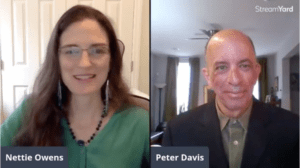Jason Howell is the owner and president of the Jason Howell Company. His company assists Gen X families who have earned or saved more money than they ever expected and want to do something special with their money.
But, as a business, how does this pertain to you? Jason shares what businesses need to know about socially responsible investing and proactive giving.
How is Socially Responsible Investing different from regular investing?
Socially Responsible Investing is a really old concept – which many people don’t realize. It’s interesting because people in the financial advising community don’t even realize how old it actually is. Socially Responsible Investing goes back at least as far as the Quakers in the 18th century. At that time, the Quakers decided that they weren’t going to do business with slave owners in the South. That was Socially Responsible Investing during those times.
Initially, Socially Responsible Investing did start as a negative screen. For several centuries, just as the Quakers did, people would decide that you were a bad company or they didn’t like your practices, and they wouldn’t do business with you.
Apartheid in South Africa is another example. If companies weren’t supporting the shift that was happening there, people started boycotting the businesses.
Recently, things have shifted again. Instead of just saying these are bad companies or good companies, companies are being asked to share data voluntarily, and people are asking: What are our concerns about these companies? Do we want to invest in any of these companies? Are you doing the right kinds of things? And, while typically, you would just look at financials, now companies are providing their governance information, their environmental impact information, their social information, how they deal with employees, and how they deal with cybersecurity. People aren’t strictly concerned about your financial data when deciding to invest in you; they want to know about your ESG Integration.
This concept of Socially Responsible Investing has been around for centuries, although we may not have called it that. Have you made this a part of your investment strategy, or are you still only looking at financials? Or, have you thought about the impact it could have on potential investors for your business as you scale?
What is ESG Integration?
ESG is Environmental Social Governance Integration.
When you are looking at a company, you want to look at the whole picture – including its ESG Integration. For example, let’s look at the coal industry. When it comes to being socially responsible, you immediately say, “They’re out.” But instead, look deeper. Is this industry looking for alternative energy sources? That could raise their score. You’re thinking should change and you might be saying, “Well, for the coal industry, what should this firm be doing? Are they looking forward to other types of alternative energies?” If they are, they get a good score for that and some consideration for investing.
For example, with Equifax, if they’re a data collection company, and they’re actually pulling my information, what’s their score on cybersecurity? After all, if they have all of your financial information, cybersecurity is an important factor – not just their financial statements. A year and a half before Equifax had their problem, they were marked as a firm with a zero out of 10 on cybersecurity. Even with that ranking, for the next year, the stock went up and up and up – until it tanked.
The reality is a lot of people, even within my profession, think this concept of socially responsible investing is just do-gooder stuff. Are you dumping in the river? Do you have a bad carbon footprint? Well, no one cared about those things with Equifax before we really started looking at ESG integration. So, if your advisor was advising you based on ESG, you might have seen those things in a company like Equifax.
ESG Integration has us looking at all the data that’s being collected. And then, we take this information and do a better fundamental analysis than we’ve ever done before.
What about your own company? Where do you stand on ESG Integration? Would you be happy to share the things your company is doing on the environmental and social side of things? Investors are now going to be asking for all sorts of different data – and you need to be prepared to share.
What is proactive philanthropy?
2020 has been this miraculous year. More and more people are giving, and the IRS is trying to make it easier. The new $300 deduction from the CARES Act is specifically for those who don’t itemize their deductions and would typically not get any tax benefit for donations. Since it’s considered an above-the-line deduction, it reduces your income prior to determining your adjusted gross income – so that’s a good thing for a lot of people.
In general, more and more people are saying, “I’d love to do more. How can I do more?” This is where we try to help. We say, “All right, we figured out your retirement plan, and we see that you’re going to have a significant amount of money leftover at the end of life, besides maybe passing that to your children. Is there anything that you want to do with those resources? What do you care about? And would you rather do it during your life work versus the end of your life?”
And remember, philanthropy doesn’t have to begin at the a high investment level. It can be very intentional and done with an annual bonus. Think about it as an investment bucket. Where do I want to distribute this across a number of different non-profit organizations? This is not necessarily limited to the wealthy.
If you’ve been inspired by 2020, as my firm has been, and as I have been personally, we switch to this area of investing so that people can do “good while doing well.” If you’ve found that you’ve been a sporadic investor or giver to different causes, it may be time to think about the causes that you do care about and do want to support. Ask yourself, “How can I do that on a consistent basis?” and choose the non-profit associations you want to support and make it part of your budget now.
While 2020 was a difficult year for many, it also seems to have brought out the best in many people as they search for ways to help. Did you find yourself giving more this year when you could? Did you have a plan for your giving? Or do you find yourself in need of a strategy that can help make your giving more effective and more closely aligned with the things you care about?
3 Action Steps
- Understand that when people are looking at your company as a potential investment, they may be looking deeper than your financial statements, and you should do the same when looking to invest.
- Look at your company’s ESG Integration as a means to see what you are doing well and where you have room for improvement, especially if you will be looking for investors in the future.
- Reassess your philanthropy strategies, so that you are giving to companies or non-profits that align with your values now and not waiting until the end of life.
Connect with Jason at https://calendly.com/jasonhowellcompany/introductory-call














No comments yet.